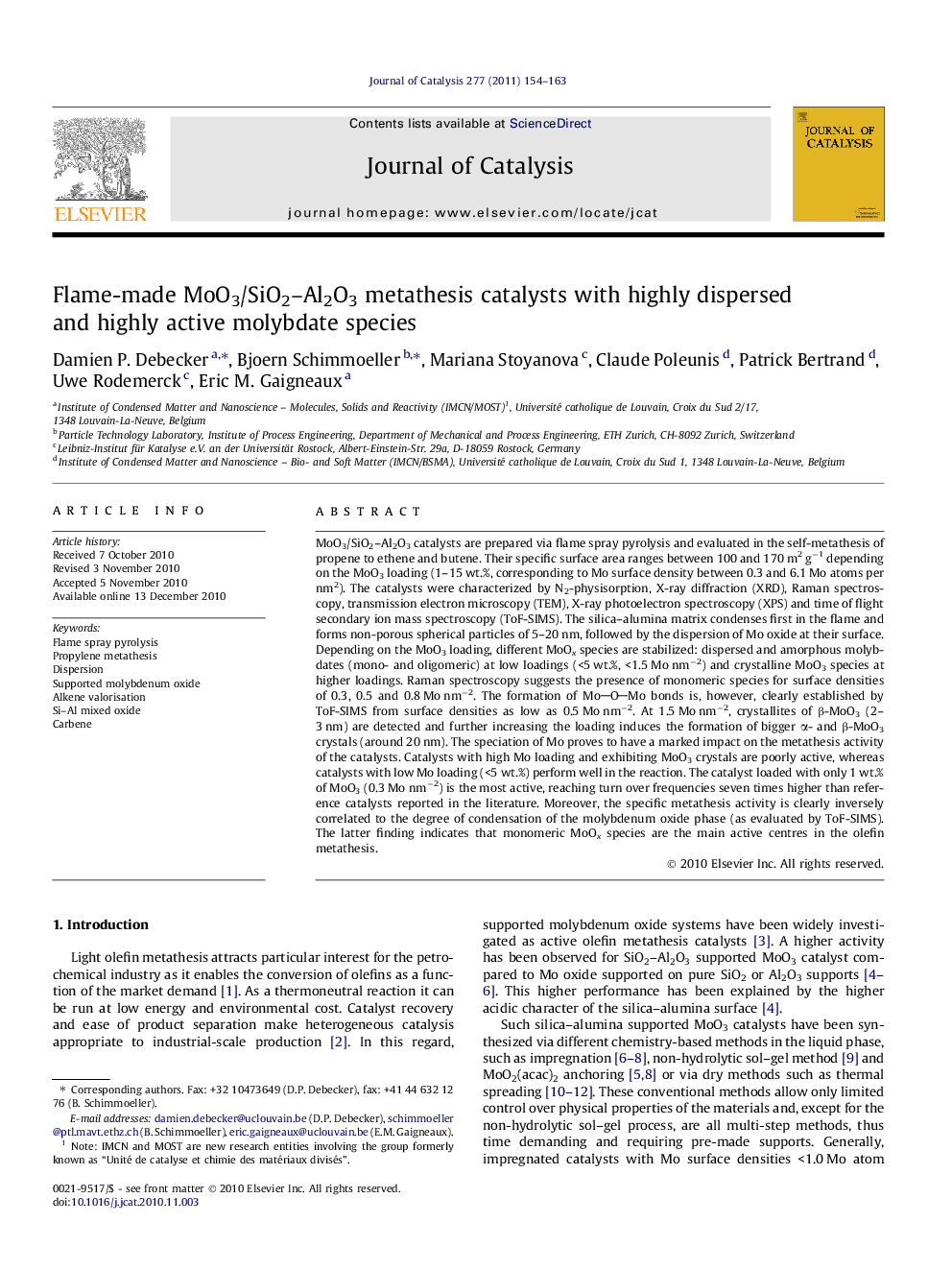| کد مقاله | کد نشریه | سال انتشار | مقاله انگلیسی | نسخه تمام متن |
|---|---|---|---|---|
| 61743 | 47603 | 2011 | 10 صفحه PDF | دانلود رایگان |

MoO3/SiO2–Al2O3 catalysts are prepared via flame spray pyrolysis and evaluated in the self-metathesis of propene to ethene and butene. Their specific surface area ranges between 100 and 170 m2 g−1 depending on the MoO3 loading (1–15 wt.%, corresponding to Mo surface density between 0.3 and 6.1 Mo atoms per nm2). The catalysts were characterized by N2-physisorption, X-ray diffraction (XRD), Raman spectroscopy, transmission electron microscopy (TEM), X-ray photoelectron spectroscopy (XPS) and time of flight secondary ion mass spectroscopy (ToF-SIMS). The silica–alumina matrix condenses first in the flame and forms non-porous spherical particles of 5–20 nm, followed by the dispersion of Mo oxide at their surface. Depending on the MoO3 loading, different MoOx species are stabilized: dispersed and amorphous molybdates (mono- and oligomeric) at low loadings (<5 wt.%, <1.5 Mo nm−2) and crystalline MoO3 species at higher loadings. Raman spectroscopy suggests the presence of monomeric species for surface densities of 0.3, 0.5 and 0.8 Mo nm−2. The formation of MoOMo bonds is, however, clearly established by ToF-SIMS from surface densities as low as 0.5 Mo nm−2. At 1.5 Mo nm−2, crystallites of β-MoO3 (2–3 nm) are detected and further increasing the loading induces the formation of bigger α- and β-MoO3 crystals (around 20 nm). The speciation of Mo proves to have a marked impact on the metathesis activity of the catalysts. Catalysts with high Mo loading and exhibiting MoO3 crystals are poorly active, whereas catalysts with low Mo loading (<5 wt.%) perform well in the reaction. The catalyst loaded with only 1 wt.% of MoO3 (0.3 Mo nm−2) is the most active, reaching turn over frequencies seven times higher than reference catalysts reported in the literature. Moreover, the specific metathesis activity is clearly inversely correlated to the degree of condensation of the molybdenum oxide phase (as evaluated by ToF-SIMS). The latter finding indicates that monomeric MoOx species are the main active centres in the olefin metathesis.
MoO3/SiO2–Al2O3 catalysts are produced in one step via flame spray pyrolysis. The solids produced consist in a silica-alumina matrix with Mo oxide on the surface. The MoOx stabilized is highly dependant on the loading. The catalysts are tested in the metathesis of propene. Characterization shows that highly dispersed species are the most active. ToF-SIMS provides detailed insight on the degree of condensation of the MoOx species at low loading.Figure optionsDownload high-quality image (54 K)Download as PowerPoint slideResearch highlights
► FSP produces MoO3/SiO2–Al2O3 catalysts in one step.
► Nature of the MoOx species depends strongly on Mo surface density.
► Mo speciation has a marked impact on metathesis activity.
► Highly dispersed Mo species are the active metathesis centres.
Journal: Journal of Catalysis - Volume 277, Issue 2, 24 January 2011, Pages 154–163